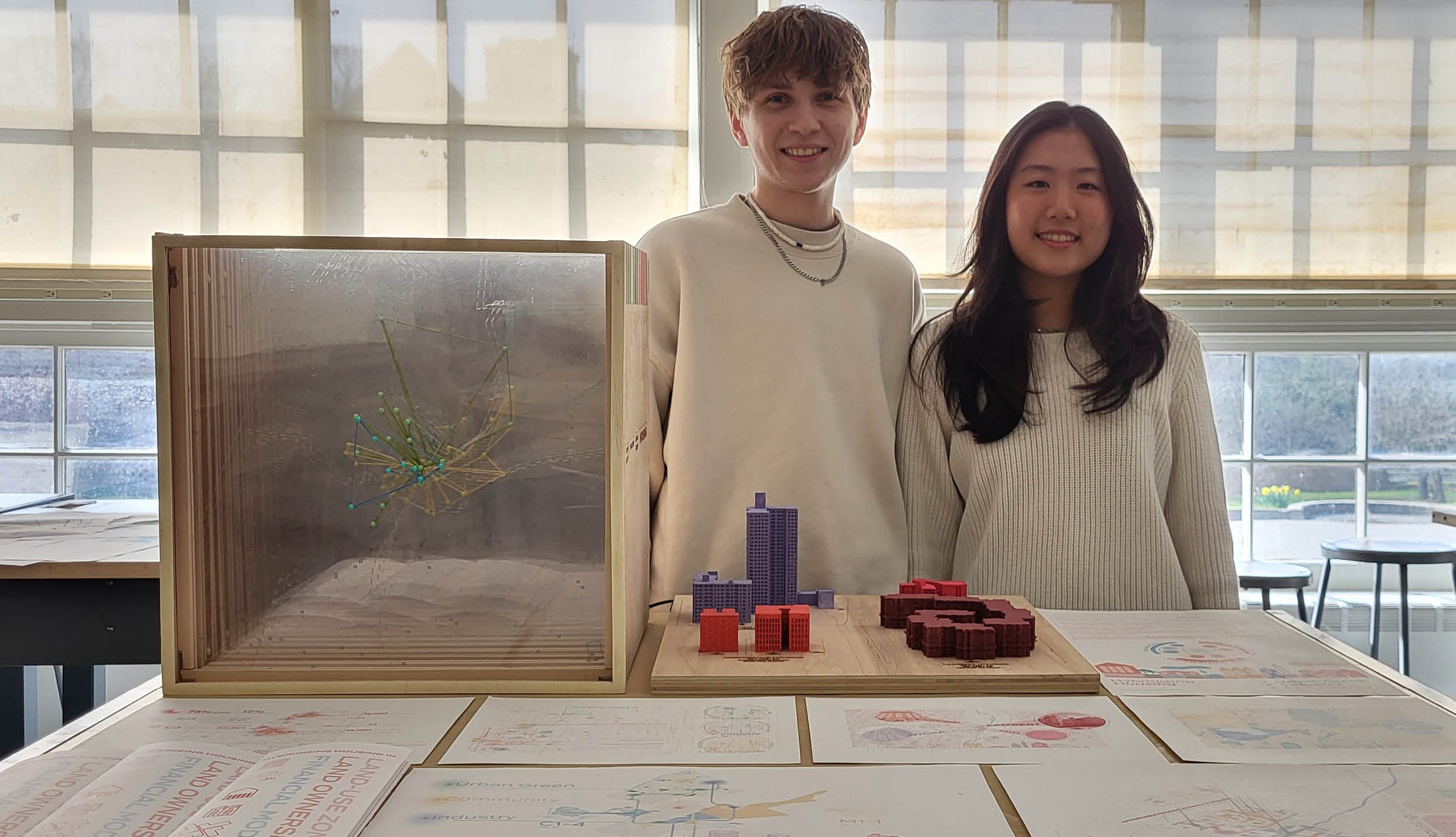
Affecting Change Through Community-based Design
April 8, 2024
Pictured: Architecture students Elise Park (right) and Kendal Eastwood work together often to build their professional skillsets.
Usually, flames are found only in chemistry labs. But for Bachelor of Architecture students Elise Park and Kendal Eastwood, sparks flew in their School of Architecture classroom on the Long Island campus during spring 2021 when the pair was partnered on a project for their architecture history course. With their shared professional goals, the couple works together often to build their skillsets and advance toward their future careers.
Eastwood, who discovered his passion through a high school class, and Park, who recalls her childhood as one full of LEGO sets and Lincoln Logs, are in love with the beauty and self-expression that architecture offers. But more than that, they agree that the profession provides a unique opportunity to foster human connection, which they are studying through their minor in Equity and Innovation.
“I’ve always known that my love for helping others needs to be at the forefront of my future career,” Park says. “Putting others’ needs before my own gratifies and fulfills me, so architecture allows me to be creative in tandem with my passion for civic engagement.”
Most recently, the duo completed research with Assistant Professor of Architecture Dong-Sei Kim, M.Des., M.S.Aud., which involved Park and Eastwood working on and redesigning technology and study spaces for middle schools in Brooklyn, N.Y. Eastwood, who was inspired by the clients’ desire to better their school communities, says there is nothing quite like the feeling of giving back through architecture and design.
The two are not strangers to working with Kim: In summer 2022, they worked as his research assistants in designing a net-zero, green energy park in Mannheim, Germany. They were tasked with developing and modeling a modular tower system to source enough renewable energy for not only the park but for the surrounding city as well.
Separately, Park worked with Kim on a project titled “Three Way Conversation,” which aims to develop conversations between different Korean identities through the manifestation of a built space. Park has also worked with Kim on his research on the Demilitarized Zone (DMZ) that separates North and South Korea. She developed a historical timeline rooted in Korean ecology, politics, and key events, and worked on a mapping graphic to generate discussion about the forgotten cities, villages, townships, and identities that became displaced by the DMZ. The two works were published in Kim’s book, Drawing Hwa-Chaeng: Mapping Contested Territories for Imagination.
Park and Eastwood’s current project involves urban design, a topic the pair is passionate about—evidenced by their additional minors in Civic Engagement and Energy Science, Technology and Policy, respectively. For this work, they researched housing typologies, land ownership models, and financial models related to housing in New York City and the lack of agency that is afforded to individuals living there. The students are proposing a spin on community land trusts and are designing a master plan in West Farms in the Bronx that gives housing ownership back to individuals and communities through a new housing typology.
When they are not performing research, Park and Eastwood work as teaching assistants (TA) for Teaching Assistant Professor of Architecture Evan Shieh, MAUD, in his Community Design course. As TAs, they shadow Shieh during critiques and collaborate on project discussions. They have also developed tutorials for software usage and have completed workshops on programming, modeling, and research for their classmates.
Helping them learn and achieve more in the field is New York Tech’s chapter of the American Institute of Architecture Students (AIAS). This organization offers students resources to advocate, network, and learn about architecture on a national scale. Eastwood serves as the group’s director of Freedom by Design, which provides the chapter with projects designed to grow the AIAS community. He is currently directing a group of students in designing a gathering space on the Long Island campus to be proposed to New York Tech in the future. Park, the chapter’s former president, serves as the fourth-year student representative, where she advises the president and executive board.
Looking ahead, Park and Eastwood each has big goals for their career, starting with graduate school. While Park plans to obtain a master’s degree in urban planning, Eastwood will pursue a master’s degree in sustainable sciences and planning. Although their graduate degree plans differ, their aspirations are the same—affecting large-scale, meaningful change through community-based design.
More Features

An Alumnus’ Commitment to the Environment
As an energy management graduate from New York Tech’s Vancouver campus, Jasdeep Gulati (M.S. ’22) is highly invested in educating people about environmental and climate sustainability.

Vancouver Faculty Win University-Sponsored Research Awards in New Program
The new Global Impact Research Grant (GIRG) program has been developed to keep Vancouver-based faculty connected to faculty and research projects being conducted on the university’s New York campuses.

Studying Climate Change One Degree at a Time
Junhua Qu (M.S. ’24) began her collegiate journey in Beijing. But, her interest in climate change took her to New York Tech’s Vancouver campus to study energy management.
